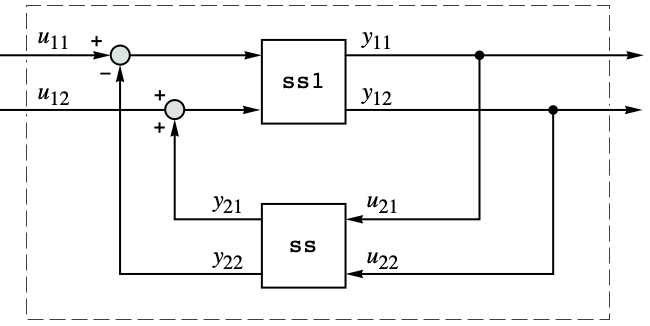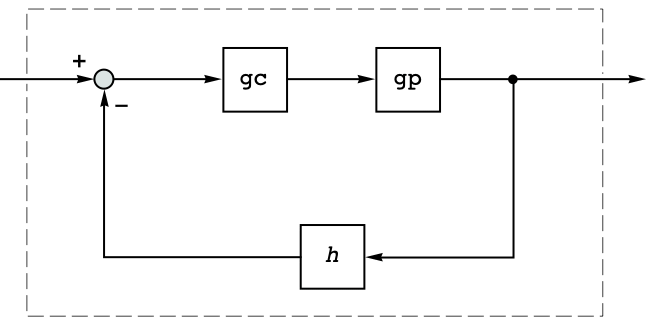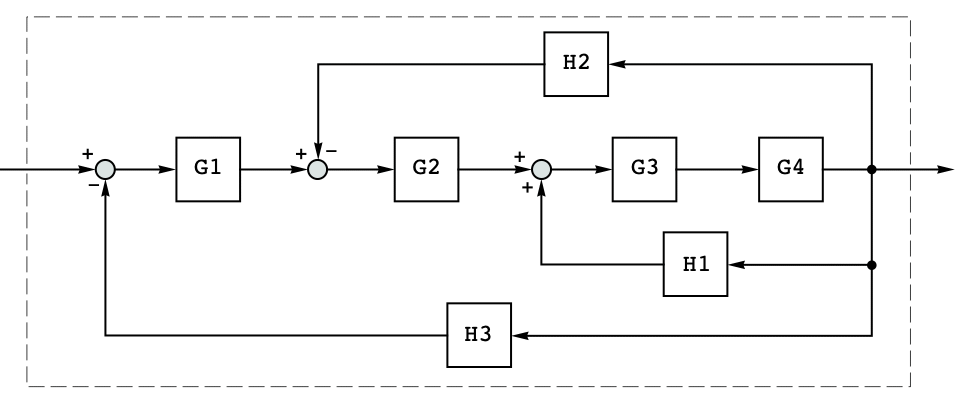SystemsModelFeedbackConnect[sys]
connects the outputs from sys to the inputs with negative feedback.
SystemsModelFeedbackConnect[sys,{con1,…}]
only feedback connect the outputs and inputs in coni.
SystemsModelFeedbackConnect[sys1,sys2]
connects the outputs of sys1 to sys2 and the outputs of sys2 to the inputs of sys1 in feedback.
SystemsModelFeedbackConnect[sys1,sys2,{out1,…},{{in1,ftype1},…}]
connects output outi of sys1 to the i![]() input of sys2 and the j
input of sys2 and the j![]() output of sys2 to input inj of sys1 with feedback type ftypej.
output of sys2 to input inj of sys1 with feedback type ftypej.


SystemsModelFeedbackConnect
SystemsModelFeedbackConnect[sys]
connects the outputs from sys to the inputs with negative feedback.
SystemsModelFeedbackConnect[sys,{con1,…}]
only feedback connect the outputs and inputs in coni.
SystemsModelFeedbackConnect[sys1,sys2]
connects the outputs of sys1 to sys2 and the outputs of sys2 to the inputs of sys1 in feedback.
SystemsModelFeedbackConnect[sys1,sys2,{out1,…},{{in1,ftype1},…}]
connects output outi of sys1 to the i![]() input of sys2 and the j
input of sys2 and the j![]() output of sys2 to input inj of sys1 with feedback type ftypej.
output of sys2 to input inj of sys1 with feedback type ftypej.
Details

- The systems model sysi can be a TransferFunctionModel, StateSpaceModel, AffineStateSpaceModel, or NonlinearStateSpaceModel.
- Connections coni can be given as:
-
{out,in} connect output out to input in in negative feedback {out,in,ftype} use positive or negative feedback type ftype - By default, sys2 is a unity gain system.
- The arguments in, out, ini, and outi are integers specifying the positions of the input or output channels.
- The ftype can be specified as "Negative" or -1 for negative feedback, and "Positive" or 1 for positive feedback. The default type is "Negative".

Examples
open all close allBasic Examples (6)
Scope (18)
Basic Uses (10)
A unity negative feedback system:
Connect multivariable systems:
Connect the second output to the first input:
Connect the second output to the first input through a feedback system:
Connect discrete-time systems:
Connect two systems in positive feedback:
Connect two state-space models as shown in the diagram:

Connect a StateSpaceModel to a TransferFunctionModel:
System Types (8)
Connect two TransferFunctionModel systems:
Using improper transfer functions:
Connect two StateSpaceModel systems:
Using descriptor state-space models:
Input linear AffineStateSpaceModel systems:
General nonlinear NonlinearStateSpaceModel systems:
Connecting a transfer function and state-space model will give a state-space model:
Connecting a standard linear system and an input linear system will give an affine model:
Connecting standard linear or affine system with a nonlinear system gives a nonlinear model:
Generalizations & Extensions (2)
Applications (5)
Obtain the closed-loop transfer function of a discrete-time system with an integral controller and feedback sensor:

A motor-load servo system with position and velocity feedback:

With only position feedback, the system is unstable:
The closed-loop system, with rate feedback in the inner loop and position feedback in the outer loop:
Use SystemsModelFeedbackConnect in multi-loop reduction:

Compute the complementary sensitivity function from the loop transfer function:
A crankshaft receives a delayed input signal from the engine controller:
Including a simple controller shows the delay is internal to the closed-loop system:
Properties & Relations (3)
The resulting system has the inputs and outputs of the first system:
SystemsModelFeedbackConnect is a special case of SystemsConnectionsModel:
Connect two transfer functions tfm1 and tfm2:
This is equivalent to (IdentityMatrix[n]+tfm1.tfm2)-1.tfm1:
Text
Wolfram Research (2010), SystemsModelFeedbackConnect, Wolfram Language function, https://reference.wolfram.com/language/ref/SystemsModelFeedbackConnect.html (updated 2014).
CMS
Wolfram Language. 2010. "SystemsModelFeedbackConnect." Wolfram Language & System Documentation Center. Wolfram Research. Last Modified 2014. https://reference.wolfram.com/language/ref/SystemsModelFeedbackConnect.html.
APA
Wolfram Language. (2010). SystemsModelFeedbackConnect. Wolfram Language & System Documentation Center. Retrieved from https://reference.wolfram.com/language/ref/SystemsModelFeedbackConnect.html
BibTeX
@misc{reference.wolfram_2025_systemsmodelfeedbackconnect, author="Wolfram Research", title="{SystemsModelFeedbackConnect}", year="2014", howpublished="\url{https://reference.wolfram.com/language/ref/SystemsModelFeedbackConnect.html}", note=[Accessed: 03-December-2025]}
BibLaTeX
@online{reference.wolfram_2025_systemsmodelfeedbackconnect, organization={Wolfram Research}, title={SystemsModelFeedbackConnect}, year={2014}, url={https://reference.wolfram.com/language/ref/SystemsModelFeedbackConnect.html}, note=[Accessed: 03-December-2025]}